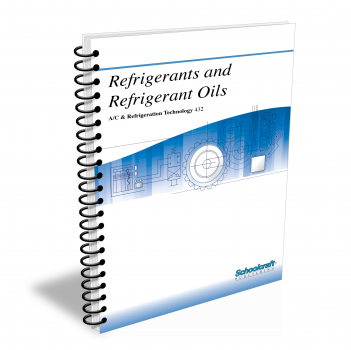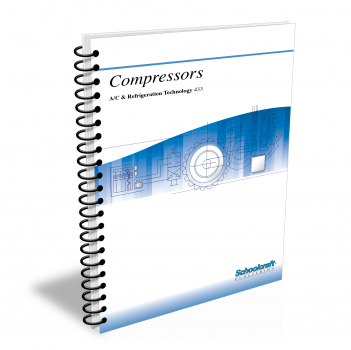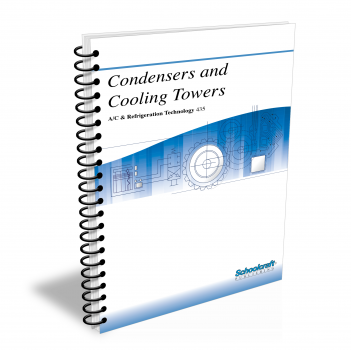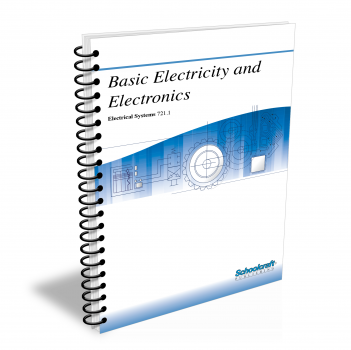The Refrigeration Cycle
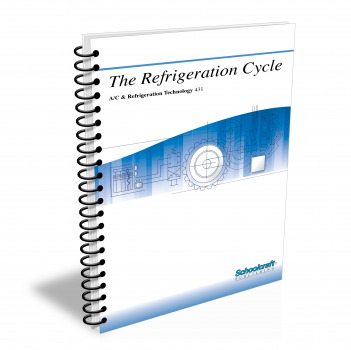
Course Number: 431
The Refrigeration Cycle textbook introduces the basic concepts needed for an understanding of refrigeration. It traces the basic refrigeration cycle and explains the concepts of heat, temperature, humidity, dewpoint, enthalpy, and simple psychometric. The course concludes with information on the tools and instruments needed for refrigeration servicing and safe work practices.
Does your curriculum require additional topics not included in this textbook? Build a customized version of The Refrigeration Cycle textbook below.
Recommended Contact Hours – 10
Preview a Chapter
Available Supporting Material
- Table of Contents
- Exam Copies
- Suggested Titles
Table of Contents
Chapter 1: Refrigeration and Air Conditioning Basics
Topics: Definition of refrigeration and air conditioning; Composition of matter; States of matter
Learning Objectives:
- Define refrigeration and air conditioning and explain how they differ.
- Describe the two methods of lowering the temperature of a material.
- Name the three physical states of matter.
- Identify what causes matter to change its state.
Chapter 2: Heat, Pressure, and Change of State
Topics: Heat; Temperature; Heat transfer; Sensible and latent heat; Heat quantity; Pressure; Importance of pressure in refrigeration
Learning Objectives:
- Explain the difference between sensible and latent heat.
- Compare the Fahrenheit and Celsius temperature scales and convert temperatures from one to another.
- Name and describe the three methods of heat transfer.
- Define latent heat of fusion and latent heat of vaporization.
- Explain the difference between absolute pressure and gauge pressure.
- Describe the effect of pressure changes on boiling point.
Chapter 3: The Basic Refrigeration Cycle
Topics: Vapor-compression refrigeration cycle; Refrigerant in action; Types of evaporators, compressors, condensers, and metering devices
Learning Objectives:
- Explain the function of each of the major refrigeration system components: evaporator, compressor, condenser, and metering device.
- Define the terms subcooling and superheating.
- Explain the function of the refrigerant in a refrigeration system and trace its path.
- Contrast dry-expansion and flooded evaporators.
- Name the five main types of compressors.
- Define cooling medium and name the two most commonly used.
- Explain the operation of the six most common metering devices.
Chapter 4: Air Properties and Simple Psychrometrics
Topics: Temperature; Humidity; Specific volume; Enthalpy; Psychrometric chart; Dewpoint temperature; Relative humidity
Learning Objectives:
- State the definition of psychrometrics.
- List the four air properties important in psychrometrics.
- Differentiate between dry- and wet-bulb temperature and tell how each is measured.
- Define the term saturated air.
- Define specific humidity and relative humidity.
- Define enthalpy and explain how it is calculated.
- Demonstrate how to use the psychrometric chart to determine dewpoint temperature, specific humidity, relative humidity, and enthalpy.
Chapter 5: Tools, Test Instruments, and Safe Work Practices
Topics: Pressure gauges; Vacuum-measuring instruments; Leak detection; Thermometers; Hygrometers; Electric test equipment; Recording instruments; Safety
Learning Objectives:
- Describe a gauge manifold and tell how it is used.
- Tell what it means to evacuate a refrigeration system and tell how it is done.
- List and describe at least three methods of leak detection.
- Explain the construction of a sling psychrometer and tell how and why it is used.
- Name the instrument used to measure relative humidity.
- Name the instrument used to measure each of the following electrical values: potential difference, current, resistance, and electric power.
- List the four classes of work area hazards, and give an example of each.
Request Exam Copies
Exam Copies
Ready to see a copy of our textbooks? After selecting which textbooks you’d like to review for your course, you can submit your request by either logging in or creating an account so we know where to ship your exam copies. A representative from Schoolcraft will contact you to confirm and finish processing your request.
Exam copies are always free and yours to keep.
Selected Exam Copies
none selected
* Maximum of five copies can be ordered
